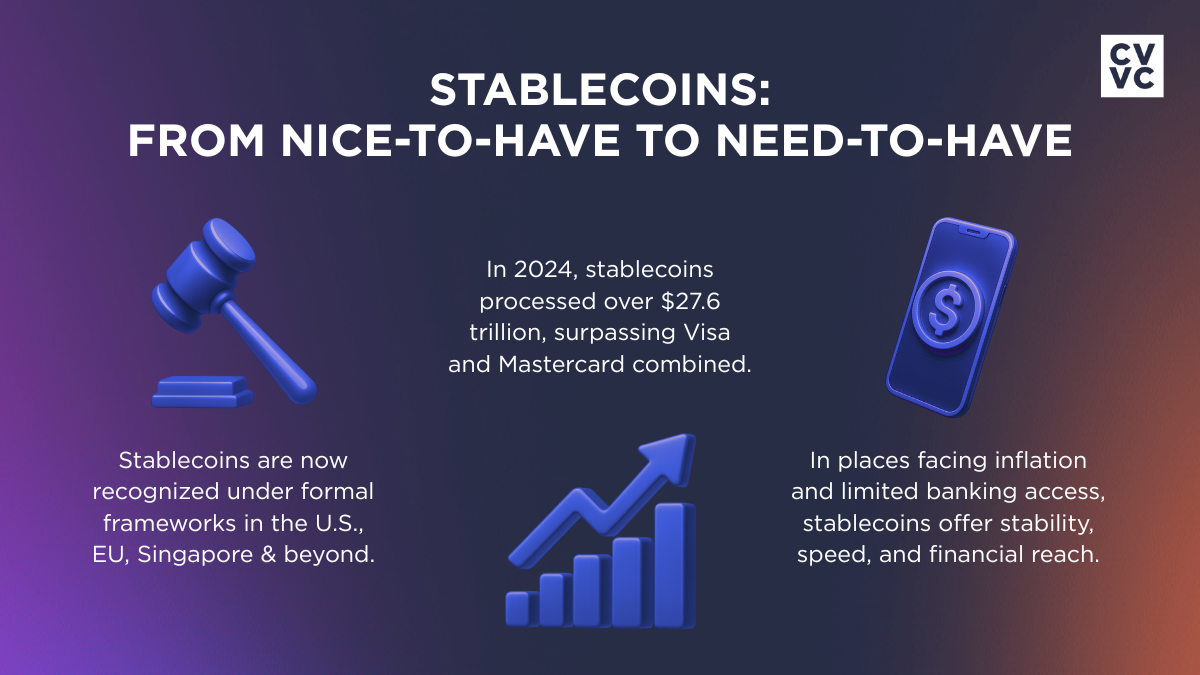Stablecoins: From Nice-to-Have to Need-to-Have

Once dismissed as just a mere niche tool for crypto traders, stablecoins have now emerged as a cornerstone of modern finance. These digital assets are no longer optional; they’re a necessity.
Why? Stablecoins are now backed by regulation, embraced by various institutions, and provide stability in volatile markets. With their international applicability, stablecoins have cemented their place in today’s global economy. Let’s further unpack why below.
Policymakers are Giving the Green Light on Stablecoins
For years, the question around stablecoins wasn’t “Are they useful?”, it was “Can they be trusted?”. That changed last June 2025 when the U.S. passed the GENIUS Act, setting clear rules: 1:1 backing with real-world assets, regular audits, and consumer protections like bankruptcy rights.
This is not the first time stablecoins have been regulated.
The Monetary Authority of Singapore (MAS) introduced a digital asset framework in 2023 that included stablecoin-specific policies. Europe followed suit with its own policies through the Markets in Crypto-Assets (MiCA) regulation. In Africa, countries like Nigeria, South Africa, and Kenya are also developing stablecoin rules, with their Securities and Exchange Commissions (SEC) leading the effort.
There’s a clear sign here: governments are legitimizing and trusting stablecoins now more than ever.
Stablecoins as a Lifeline
For developed countries, stablecoins might feel like next-gen convenience, but in emerging markets, they’re a lifeline. In places facing high inflation and limited banking access, stablecoins offer what traditional systems often can’t: stability and financial reach.
For example, five-day transaction delays and fees of up to 8% per transfer have led many Africans to turn to dollar-pegged stablecoins like USDT for remittances and value protection, as published in the latest African Blockchain Report by CV VC and Absa Corporate and Investment Banking. Meanwhile, in Latin America, crypto remittances rose to 40%, driven by stablecoins. Across Southeast Asia, 20% of the population holds crypto as they face similar economic pressures.
In a landscape where banks are unreliable and traditional assets are weak, stablecoins have emerged as the digital gold of the people, delivering stability and reliability where they’re needed most.
What Makes Stablecoins Essential?
Stablecoins were not built to ride the crypto hype. They were meant to go beyond the metas of the vicious cycle of bear runs and bull runs. Stablecoins were built to solve real-world financial problems. And in today’s economy, these digital assets have provided the utility necessary to bridge the gaps between traditional and digital finance. Stablecoins also offer other benefits that go beyond convenience:
- Stability - Pegged to fiat, they offer predictable value, unlike volatile cryptocurrencies.
- Accessibility - Anyone with a phone and internet can use stablecoins without a traditional bank.
- Lower Costs - They cut fees drastically compared to banks and remittance services.
- Transaction Speed - They settle transactions instantly, bypassing banking delays and borders.
- Transparency - Public blockchains and reserve reports make stablecoins easy to verify.
- Interoperability - They connect TradFi and DeFi, enabling seamless financial integration.
- Programmability - They can embed rules and logic into transactions, automating payments, compliance, and financial workflows.
Businesses are Paying Attention
Businesses around the world, from e-commerce to global suppliers, are embracing stablecoins for all their benefits.
As debates around the GENIUS Act gained more traction, big tech companies are pushed further to integrate their operations with digital assets. Apple, X, and Google are reportedly exploring stablecoins to streamline international transactions since there is reduced friction upon checkouts and a decrease in cross-border processing costs.
Adoption of stablecoins as a means to operate is not just an option anymore, it’s a necessity in today’s fast and borderless economy.
In Conclusion
What happens when a tool proves itself across regulation and utility? It stops being optional, and it becomes an infrastructure.
Stablecoins are continuously taking center stage and are taking the world by storm, especially in places where they are needed the most. To ignore the relevance of stablecoins is to ignore the present and a future where financial infrastructure is more reliable and accessible for all.
.svg)




.png)
.png)
.png)
Comments